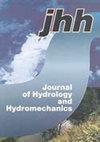Simplified dispersion analysis based on dye tests at a small stream
IF 2.4
4区 环境科学与生态学
Q3 WATER RESOURCES
引用次数: 0
Abstract
Abstract The modelling of solid transport in open channels requires good knowledge about parameters related to basic processes such as hydrodynamic dispersion, advection and decay rates. Such parameters are usually determined by dye tests. Numerous tracer studies have been performed on laboratory flumes and natural rivers. However, on-site sampling is often difficult, expensive and needs special apparatus. The main aim of the study was to justify simplified method based on the monitoring of the dye cloud shape in order to determine both longitudinal and transversal dispersion coefficients. In this study, four dye tests were carried out on a small local stream (the Lipkovsky) using Rhodamine WT fluorescein dye as a tracer. The tests were carried out in such a manner that both longitudinal and horizontal transversal dispersion data were obtained. For this purpose, the visually determined extent of the dye cloud was interpreted via the analytical solution of the advection-dispersion equation. The results obtained by this simplified approach indicated that the longitudinal dispersion coefficient Dx = 0.051–0.057 m2/s and the coefficient of horizontal transversal dispersion Dy = 0.00024–0.00027 m2/s. The method was justified by corresponding root mean square error (RMSE) counting RMSE = 0.65–1.02 m for the dye cloud centre, RMSE = 1.87–2.46 m for the head and tail of the cloud and RMSE = 0.025–0.11 m for the cloud width, the Nash-Sutcliffe efficiency coefficients ranged from 0.9 to 0.998. The comparison of these values with empirical formulae and other tracer studies indicated significant overestimation of the mentioned values of Dx, which can be attributed to the uniform velocity distribution along the width of Lipkovsky Stream. Much better agreement was achieved for Dy.基于小流染料试验的简化色散分析
明渠中固体输运的模拟需要很好地了解与水动力弥散、平流和衰减率等基本过程相关的参数。这些参数通常由染料试验确定。对实验室水槽和天然河流进行了大量的示踪剂研究。然而,现场取样往往是困难的,昂贵的,需要特殊的设备。该研究的主要目的是证明基于染料云形状监测的简化方法,以确定纵向和横向色散系数。在这项研究中,使用罗丹明WT荧光素染料作为示踪剂,在一个小的局部流(利普科夫斯基河)上进行了四种染料试验。进行试验的方式是获得纵向和横向色散数据。为此,通过平流-色散方程的解析解来解释视觉上确定的染料云的范围。结果表明:纵向色散系数Dx = 0.051 ~ 0.057 m2/s,横向色散系数Dy = 0.00024 ~ 0.00027 m2/s。采用相应的均方根误差(RMSE)计算染料云中心RMSE = 0.65-1.02 m,云的头部和尾部RMSE = 1.87-2.46 m,云的宽度RMSE = 0.025-0.11 m,证明了该方法的有效性,纳什-苏特克里夫效率系数范围为0.9 - 0.998。这些值与经验公式和其他示踪剂研究的比较表明,上述Dx值明显高估,这可归因于沿利普科夫斯基流宽度均匀的速度分布。Dy得到了更好的一致。
本文章由计算机程序翻译,如有差异,请以英文原文为准。
求助全文
约1分钟内获得全文
求助全文
来源期刊
CiteScore
4.20
自引率
5.30%
发文量
30
审稿时长
>12 weeks
期刊介绍:
JOURNAL OF HYDROLOGY AND HYDROMECHANICS is an international open access journal for the basic disciplines of water sciences. The scope of hydrology is limited to biohydrology, catchment hydrology and vadose zone hydrology, primarily of temperate zone. The hydromechanics covers theoretical, experimental and computational hydraulics and fluid mechanics in various fields, two- and multiphase flows, including non-Newtonian flow, and new frontiers in hydraulics. The journal is published quarterly in English. The types of contribution include: research and review articles, short communications and technical notes. The articles have been thoroughly peer reviewed by international specialists and promoted to researchers working in the same field.

 求助内容:
求助内容: 应助结果提醒方式:
应助结果提醒方式:


